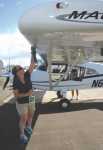Transcontinental air race makes its first stop in Mountain Home

One by one, the aircraft made their way to Mountain Home. Already several hours behind schedule due to foul weather that delayed their departure, several of the single-prop aircraft flew over town on their way to their next destination. A few others chose to land at the city airport to prepare for their next flight.
Last Tuesday, Mountain Home served as the first stop in a yearly air race across the United States. Billed as the longest running transcontinental air race featuring all-women pilots, the 37th Annual Air Race Classic covered more than 2,100 miles in just four days.
Cloudy skies and foul weather at the race's starting point in Pasco, Wash., kept the nearly 50 aircraft grounded for six hours until conditions improved. Race officials didn't want to start the race unless everyone had the same opportunity to fly out of Washington the same day, said Zia Safko, whose aircraft was the first to land here.
The rules of the race normally limit pilots to fly during daylight hours using visual flight rules. However, race officials gave the teams the option to chart an instrument flight path during that first leg because of the clouds.
In addition, the delay out of Washington State prompted organizers to make Mountain Home the new, official starting point for this year's competition.
Before the race began last week, each team was required to fly their aircraft in race configuration to determine each planes' handicap speed, organizers said. The challenge was for each team to reach actual ground speeds as far over the handicap speed as possible between each race leg.
"It's a strategy race. It's all about decision making as a pilot," said competitor Jessica Vinson.
"We want the best winds that we can get," Safko added. "That's the reason why we stopped in Mountain Home. That was our game plan."
In this type of race, the official standings are not known until the last aircraft crosses the finish line. Simply put, in some cases, the last plane to arrive in Arkansas could end up as this year's winner.
As the race began, the crews dealt with a fair share of rain and wind as they flew over the mountains, making the first leg "a bit bumpy on the way here," Ellen Herr said.
The thick cloud layer remained fairly low to the ground, leaving flying conditions "pretty wishy washy," Safko added.
As the lead aircraft made their way over the mountains, the teams would report the weather conditions to the trailing crews.
"We were all helping one another so we could get everyone here safely," Herr said.
Once they got past the mountains, they had clear skies all the way to Mountain Home, the teams added. Many of them took advantage of visual landmarks, in particular the interstate, to navigate their way here.
While many of the competitors had a few years of flight time, others had a lifetime of piloting experience. Often, these women were inspired to fly from their parents.
Bailey Ryan earned her private pilot's license 11 years ago. She continued a tradition started by her father, who flew commercial jets.
Safko started flying five years ago shortly after she graduated from high school. She was drawn into flying by her mother, who also worked for an airline.
"There's no better way to see the world than to fly it myself," Safko said.
Vinson, meanwhile, was taught by her father, who flew his own private aircraft.
"He threw me in the front seat and made me learn how to fly," she said.
While the spirit of competition and prize money convinced some people to join this year's race, others had personal reasons.
"It sounded like fun, and we're in it for the adventure," said Emily Applegate, who served as the Safko's co-pilot.
In addition, the 2,100-mile route gave the competitors a chance to put their piloting skills to the test.
"We basically have a chance to fly across the country, which don't get many times to do," Applegate said.
In addition to the challenges, the allow teams to visit communities across the country and to meet people from all walks of life, Herr added.
Several of this year's pilots have competed in this race many times in the past. Taking time to clean the team's aircraft as they prepared for the next leg of their journey, Sarah Morris said that she had competed three times in the past four years.
"I had so much fun the last two times that I was dying to do it again," Morris said.
